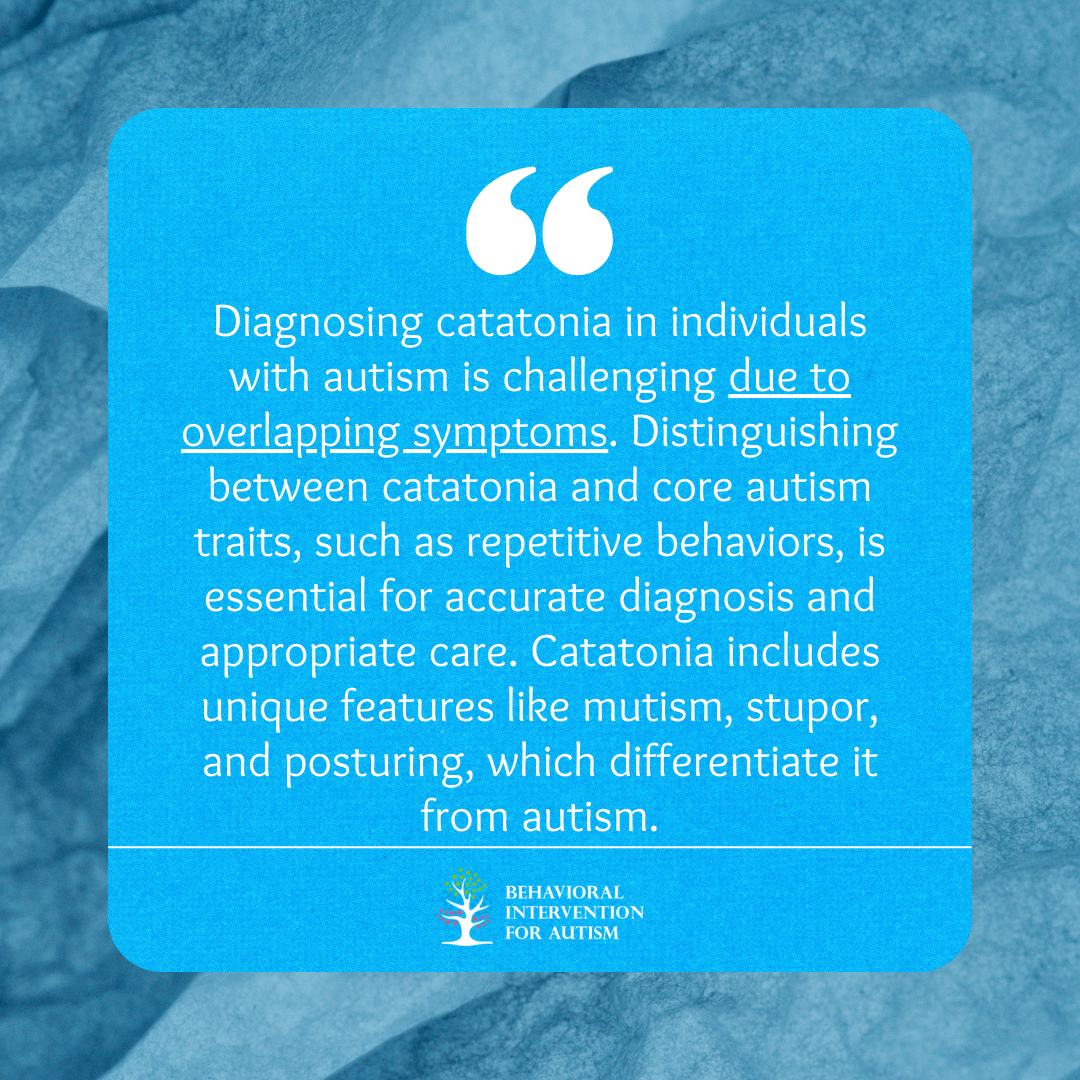
Table of Contents
Examining the interplay between autism and catatonia requires defining catatonia within the context of autism. Recognizing and addressing catatonia in individuals with autism is crucial for providing appropriate support and interventions.
Defining Catatonia in the Context of Autism
Catatonia in autism is characterized by a range of motor abnormalities, such as stupor, posturing, echolalia, and negativism. These symptoms can significantly impact an individual’s communication, social interactions, and overall functioning. Recognizing these unique features of catatonia in the autism population is crucial for accurate diagnosis and targeted treatment.
The Significance of Recognizing and Addressing Catatonia
Identifying and addressing catatonia in individuals with autism is paramount due to its potential to exacerbate the existing challenges associated with autism spectrum disorder (ASD). Left untreated, catatonia can hinder a person’s ability to engage in daily activities, participate in therapy, and interact with others effectively.
Recognizing catatonia in autism allows caregivers and healthcare professionals to implement strategies that improve quality of life. Early intervention leads to better outcomes and well-being for individuals facing both conditions. A holistic approach that addresses both autism and catatonia symptoms is essential for providing comprehensive, tailored support.
Potential Causes of Catatonia in Autism
Exploring the factors contributing to catatonia in individuals with autism involves considering neurobiological factors, genetic predispositions, and environmental triggers.
Neurobiological Factors
Neurobiological factors play a significant role in the development of catatonia in autism. These factors involve abnormalities in the brain structure and function that can impact motor control, processing of sensory information, and overall neurological pathways. Understanding the intricate interplay of these factors is essential in unraveling the complexities of catatonia within the context of autism.
Genetic Predispositions
Genetic predispositions are another key element to consider when examining the causes of catatonia in individuals with autism. Research suggests that certain genetic variations or mutations may increase the susceptibility to developing catatonia. By analyzing genetic profiles and familial history, healthcare professionals can gain valuable insights into the genetic underpinnings of this comorbidity.
Environmental Triggers
Environmental triggers can also play a crucial role in precipitating catatonic symptoms in individuals with autism. Factors such as high levels of stress, trauma, changes in routine, or sensory overload can act as triggers for catatonic episodes. Recognizing and mitigating these environmental stressors is essential in managing and preventing the onset of catatonia in individuals with autism.
Considering the interplay of neurobiological factors, genetic predispositions, and environmental triggers helps caregivers and healthcare providers better understand the causes of catatonia in individuals with autism. This approach is essential for developing tailored interventions and support strategies to improve the well-being of those experiencing catatonic symptoms.
Diagnostic Challenges

The overlap of symptoms, such as stereotyped movements in autism, can lead to misinterpretation and misdiagnosis. This highlights the need for a thorough assessment by trained professionals to ensure accurate identification and intervention.
Accurate diagnosis requires a comprehensive evaluation that accounts for both autism and catatonia characteristics. Collaboration between healthcare professionals and caregivers is crucial to provide the right care and support for individuals with autism and catatonia.
Treatment Approaches for Catatonia in Autism
In addressing catatonia in individuals with autism, various treatment approaches are utilized to manage symptoms effectively. The treatment strategies for catatonia in autism primarily focus on pharmacological interventions and psychotherapeutic strategies.
Pharmacological Interventions
Pharmacological interventions play a crucial role in managing catatonia in individuals with autism. Medications are prescribed based on the specific symptoms and severity of catatonia. The table below provides an overview of commonly used pharmacological interventions for catatonia in autism:
Medication Class | Example Medications | Mechanism of Action | Potential Side Effects |
Benzodiazepines | Lorazepam, Diazepam | Enhance GABA activity | Sedation, dizziness |
Antipsychotics | Risperidone, Aripiprazole | Modulate dopamine receptors | Weight gain, metabolic effects |
Mood Stabilizers | Lithium, Valproate | Stabilize mood and reduce impulsivity | Liver toxicity, weight gain |
It is essential for healthcare providers to carefully monitor the individual’s response to medication and adjust the dosage as needed to optimize treatment outcomes. Additionally, potential side effects should be thoroughly discussed with caregivers to ensure informed decision-making.

Psychotherapeutic Strategies
In addition to pharmacological interventions, psychotherapeutic strategies are vital in helping individuals with autism navigate and cope with catatonia. Psychotherapy aims to address emotional and behavioral challenges associated with catatonia. Different psychotherapeutic approaches can be beneficial, including:
- Cognitive Behavioral Therapy (CBT): Helps individuals identify and modify negative thought patterns and behaviors.
- Applied Behavior Analysis (ABA): Focuses on reinforcing positive behaviors and reducing negative behaviors through a structured approach.
- Occupational Therapy: Assists individuals in developing adaptive skills to improve daily functioning and independence.
Psychotherapeutic strategies should be tailored to the individual’s specific needs and preferences. Collaborating with a team of healthcare professionals, including therapists and behavioral specialists, can provide comprehensive support for individuals with autism experiencing catatonia.
Supporting Individuals with Catatonia in Autism
Creating a supportive environment and collaborating with healthcare professionals are crucial for managing catatonia in individuals with autism, especially when a dual diagnosis disorder is present. Key strategies for support include establishing a clear routine to reduce anxiety, designing sensory-friendly spaces to avoid overload, using communication aids to enhance understanding, and developing individualized care plans to address specific needs.
Collaboration with healthcare professionals ensures a comprehensive care approach. This involves consulting with a multi-disciplinary team, maintaining regular communication with providers, involving caregivers in treatment planning, and seeking specialized care for tailored interventions.
Combining a nurturing environment with professional collaboration helps parents and caregivers enhance care and support for individuals with autism and catatonia, promoting their well-being and development.

Get Support for Catatonia and Autism Today
Catatonia in autism can result from a variety of factors, including stress, sensory overload, or medical conditions. Understanding the underlying causes can help caregivers and professionals better address this challenging aspect of autism. By providing targeted interventions, we can work together to alleviate the impact of catatonia and improve overall well-being.
Behavioral Intervention For Autism offers ABA therapy in Florida, delivering personalized strategies that address the unique needs of individuals with autism. Our team of experts is dedicated to helping individuals manage symptoms and develop vital skills for a brighter future. Don’t hesitate to get in touch with us today to learn how we can support you or your loved one.
- 9 Common Obsessions of Children With Autism You Should Know - February 25, 2025
- What is Neurodiversity? A Guide to Embracing Differences - February 25, 2025
- Understanding Hyperfocus in Autism: What It Means and Why It Happens - February 25, 2025
